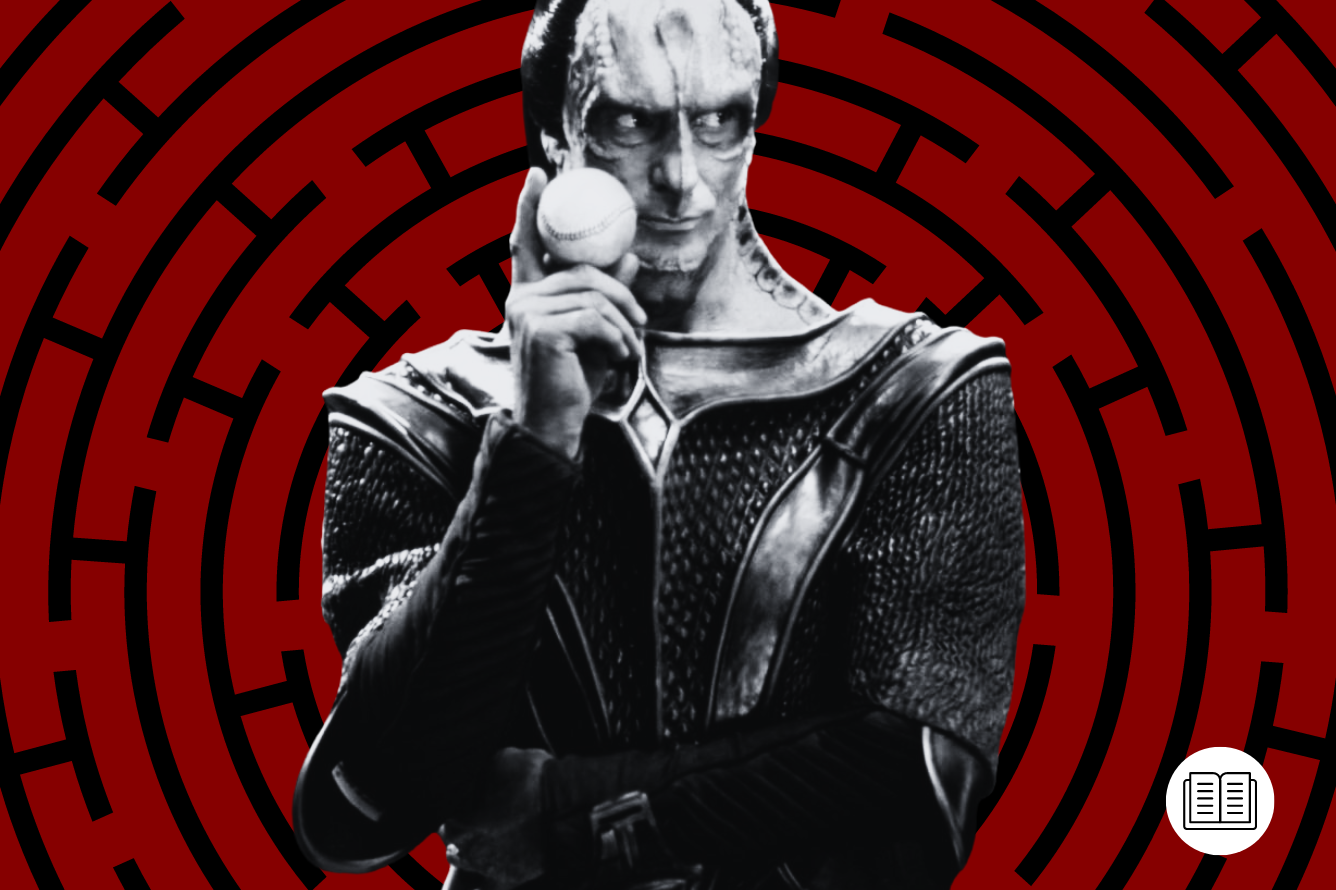As a huge fan of Star Trek, it pains me to admit I sometimes struggle with episode reviews and recaps. Don’t get me wrong, they’re often written by accomplished mega-fans, who have a deep, sincere love for the show and conduct a thorough amount of research. These reviews and similar forum discussions are what kept Trek relevant to new and old fans in the early-Internet age in the extended hiatuses between iterations of the show. But something keeps bothering me the more I dive into the recaps, something that’s common in fandoms of sci-fi/fantasy universes; occasionally some fans prioritize the logic and realism of an episode, deciding whether they approve of an episode based on how much it violates their investment in the fictional Trek canon.
I don’t mean to burst anyone’s bubble, but Star Trek isn’t real. The Federation and beyond are vast and fascinating, but we shouldn’t be watching it to see how convincingly their galaxy is constructed. This prioritization inherently diminishes what I think is the much more compelling way of engaging with fiction: stories should not be graded on their adherence to an in-universe continuity, but on how they dramatically employ its universe to make us understand how people act and feel.
The Federation, the Klingons, and the Cardassians are not at their most interesting in isolation, but in how they affect people’s psychology, ethics, and the ways they view and build relationships. You can break the delicate equilibrium of “logic” in Star Trek’s galaxy if you’re telling me something fresh and insightful about the people who live in it. It’s one of the reasons ‘Civil Defense’ (S3, Ep9) is a particularly strong episode of Star Trek: Deep Space Nine.
Why Terok Nor Will Never Be Home
Deep Space Nine is, of course, not the original name for the space station Benjamin Sisko (Avery Brooks) and his loyal crew live in. Its Cardassian name was Terok Nor, as it was these scaly, angular-armored fascists that built and ran the station up until their empire was ousted from Bajoran space, and Starfleet arrived to oversee the aftermath. It’s one of the most compelling aspects of early DS9 – our heroes are not operating from the familiar safety of a Galaxy-class starship of their own design, but a foreign, already-populated enemy vessel where diplomacy is pivotal even if its crew were not the most accomplished. Chief O’Brien (Colm Meaney) has to push his engineering expertise to its limits, Kira (Nana Visitor) has to adapt her leadership skills from the revolution she got them from, and Sisko has to try not to punch people in service of bureaucracy. Deep Space Nine is crucially not theirs, constantly challenges their expectations, and very occasionally tries to kill them.

As Jake (Cirroc Lofton) aids O’Brien with some engineering malarkey, they accidentally set off an ancient Cardassian counter-revolutionary program designed to stop Bajoran laborers rebelling on the station. With every action our crew takes to deactivate the program, the problem only compounds, interpreting their every move as that of Bajoran rebels. The big Cardassian characters, including Garak (Andrew Robison) and Dukat (Marc Alaimo), end up being trapped with them, and it’s gonna take some serious Treknobabble for our heroes to get out alive, as it turns out the Cardassians are very much willing to destroy their station to stop the insurgency.
‘Civil Defense’ is not meant to be taken completely seriously; it has the boisterous, light-hearted tone that characterizes a lot of Star Trek “action-adventure-puzzle” episodes, with the mostly well-observed comedy in the face of dark circumstances that DS9 made work so wonderfully. It may be easy to see it as fluff, and there’s certainly nothing wrong with enjoying it as such. ‘Civil Defense’ can be easily critiqued – why, in Season 3, is there still an active Cardassian kill program fit with working canisters of neurocine gas? – and therefore readily dismissed, but aside from missing out on a richness of character and some peak comedy, poking holes in its logic misses the central metaphor this episode represents. Deep Space Nine is not a safe space, this is a thorny, hostile environment loaded with past trauma and ongoing violence. As Bashir (Alexander Siddig) says, “I’ve been here nearly three years, and I was just finally starting to think of this place as home.” Kira replies, “Your home was built by Cardassians, doctor, don’t ever forget that.”
The Cardassian State of Mind
There are a lot of Trek episodes where the ship starts acting violently toward its inhabitants. Alien parasites, saboteurs, and malfunctions; they’ve all contributed to catastrophic system failures and computer anomalies that sent all the various Trek crews into chaos. Unlike the misadventures of the Enterprise or Voyager crews, ‘Civil Defense’ shows a computer system not being hijacked or malfunctioning, but operating exactly as programmed. There is no anomaly; the Cardassians inscribed into the DNA of their space station an automated kill switch to be used on their protectorate.
In contrast to the ship-trying-to-kill-you episodes that have come before and after, there’s willful intent to the threat in ‘Civil Defense’, a reminder that even though Starfleet succeeded in shutting out the oppressors, they are still trying to kill you, and despite only seeing it in small glimpses throughout the show, the violence they once carried out has a way of rearing its head for fresh attacks. There’s a tension that isn’t reset at the end of every episode, a consistent, underlying threat that will take more than nine able-bodied chiefs-of-staff to smooth over. All they can hope for is fixing whatever immediate, pressing issue has cropped up, and hope things stay calm until they encounter the next symptom of space PTSD.

But the Cardassian presence lurking at the corner of every viewscreen isn’t just explored in terms of narrative tension; ‘Civil Defense’ ingeniously presents their oppressive might as something worthy of mockery and derision, in the process revealing how pathetic an empire they are in the face of the worthy Bajorans and tactical Starfleet. DS9 is the darkest Trek series whilst also being the funniest, excelling in being playful with confronting subject matter. When the program first awakens, it triggers a recording of Gul Dukat warning the Bajoran workers to stop their revolting, and Marc Alaimo’s pitch-perfect smugness works just as brilliantly in talking head form, made all the funnier by the fact he isn’t talking to the people he thinks he is. It would be like if you found a voicemail from Dukat when he thought you picked up the phone, or if he tried to videochat you over a significant internet lag.
Every time Sisko’s crew triggers an escalation of the threat, Dukat reappears, to the hilarious extent that you start imagining what the process for recording these was like – Dukat sitting down in front of a teleprompt explaining all the various, complex, and specific ways a Bajoran rebellion could progress. He’s like when an escape room plays pre-recorded bits from a B-list genre actor to spruce up the experience, or those mid-2000s DVD interactive minigames you might be lucky to find one of the actors in.

Why are these recorded anyway? Is it so they could lock the Bajoran rebels somewhere no Cardassians could be hurt? But why did it have to be automated, why not speak to them over the intercom? Did Bajorans revolt so frequently that it made economic sense to invest in an automatic program? Or was this one of the first things they arranged, indicative of the Cardassian mindset to always predict dissent against them? Maybe their prioritization of efficiency and smoothly executed “trains-running-on-time” fascism means they’d design something that would involve little effort down the line. While the intrusion of Dukat continually popping up to dissuade the “rebels” from preventing their own demise is hilarious, it affirms what we’ve seen before of the Cardassians, giving a glimpse into their pre-liberation behavior outside of Starfleet scrutiny.
The Trap Closes on Gul Dukat
As Zack Handlen for AV Club points out, the key to any dramatic stakes (or comedic sketch) is escalation. The Cardassians are so proud, they’d rather blow up the station than concede it to any potential rebels – and a self-destruct countdown begins. It’s a fitting parallel to how they feel about Terok Nor’s newest occupants; while this episode sheds light on life on the station before the show began, it’s also reflective of what the Cardassians would happily do towards Sisko’s gang. This is faintly implied as the episode proceeds; after the program has assumed the tampering from the crew on Ops has come from Bajoran infiltrators, the replicator starts firing phaser blasts on every non-Cardassian on deck. Cue Gul Dukat beaming in like the hideous cad he is, with the biggest shit-eating grin imaginable. He just happened to be patrolling the demilitarised zone when he picked up his own recording and came by to be of assistance – on his terms.

As he pushes for reintroducing a Cardassian presence on DS9, it’s possible to read some secretive intentions behind his slippery tone. Was it really the case that this program was so deeply buried Starfleet never found it or was it designed to stay hidden and be triggered even after Cardassians left, to be used as leverage over their new rivals? If this is the case, it's more likely this wasn’t something sanctioned by Central Command; maybe Dukat conspired independently due to his personal obsession and grievance with Terok Nor, Sisko, and the Bajorans.
This is complicated further by Dukat’s hubris slapping him in the face. When he tries to beam away, he activates a deeper, buried protocol in the defense program – one that assumes an occupation-era Dukat has tried to flee a sinking ship, so a recording of Legate Kell revokes his security clearances and leaves him to die there like the honorable Cardassian he is. It’s a great move to undermine the swaggering authority Dukat’s enjoyed too much through the episode, putting him on the same playing field as our heroes, but it’s also one of the funniest punchlines in all of DS9. It turns out the program goes even deeper than Dukat thought and includes a lot of that trademark Cardassian backstabbing. Not only will these people automate a kill program with no need for Cardassian interaction, but not only would they rather self-immolate than lose control, but they even managed to code in their own personal biases and grudges.
Odo vs Quark/Kira vs Dukat
Dukat isn’t the only character that the episode wrings great moments from. As the people who set off the program in the first place, Sisko and O’Brien readily shoulder their responsibilities of being the most hands-on, down-and-dirty workhorses on the station, wrenching handles from bulkheads and glowing wires from walls when shit needs to get done. Joining them is Jake, who jumps at the chance to please two men he idolizes, including climbing into a processing chute within the first five minutes of the episode. ‘Civil Defense’ also proves that Odo (Rene Auberjonois) and Quark (Armin Shimerman) could be trapped in a vacuum (or a sealed-off security office) and still have the best chemistry of anyone in Star Trek, and up on Ops, we get to see Kira’s Cardassian prejudices out in full force, facing not just the cruelty of her former oppressors, but the fury conjured when they try to reimpose on her authority. “I will destroy this station before I ever give it back to the Cardassians,” she tells Dukat, mirroring how similarly the Cardassians feel about having DS9 in Bajoran hands.

Kira, however, suffers from some misjudged characterization in this episode; fans and even Nana Visitor herself have expressed displeasure at Dukat’s clear romantic/sexual interest in Kira being played off as a joke. For a show that so regularly handles the balance between the grim and comedic, it’s a clear misstep from the writers – probably due to how taxing and laborious a writing process this episode was. Pretty much the entire writing staff had a go at redoing Mike Krohn’s original draft in a short space of time, because, as writer/producer Ronald D. Moore says in Star Trek: Deep Space Nine Companion (2000), they struggled “to make the jeopardy intriguing, to find the inner story.” They definitely found it in the end; what appears like a frothy adventure puzzle shows complexities beneath its comedy, where the action is metaphor, and the characters reflect on the relentlessness with which Cardassia will haunt those who took its place.
This article was first published on November 8th, 2022, on the original Companion website.
The cost of your membership has allowed us to mentor new writers and allowed us to reflect the diversity of voices within fandom. None of this is possible without you. Thank you. 🙂









